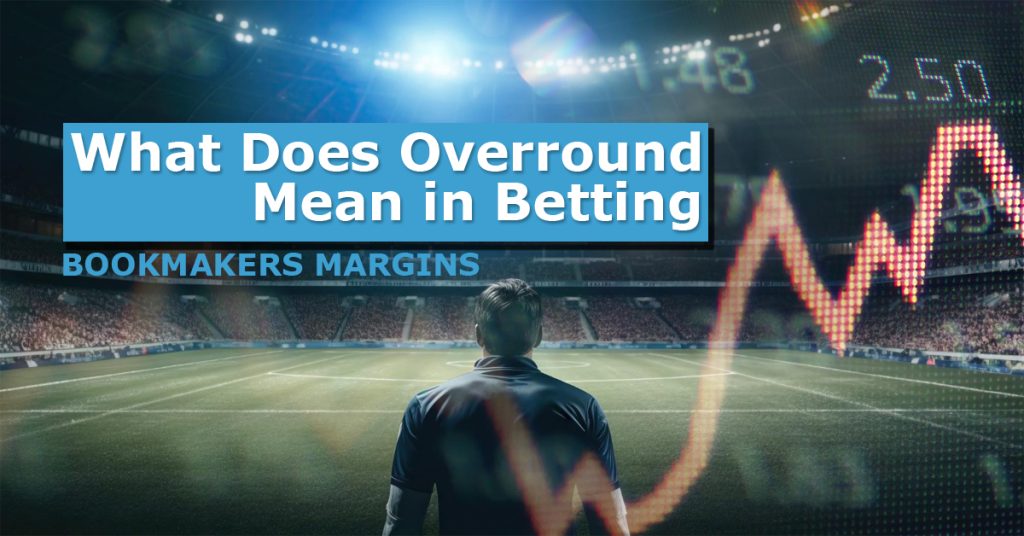
All of the odds on the result of a particular event added together is known as the overround. The main goal is to provide the betting sites with a profit margin that guarantees them a profit no matter what the result.
Overround, Margin & Payout in Betting Explained
Because it rates markets heavily in their favour, overround is essential to a bookmaker’s operation. This is because its design ensures that the bookies will continue to earn a profit even if every event aspect is equal. Like any other enterprise, bookmakers operate to maximise profits, but they also exist to help consumers enjoy sports betting to a greater degree. An event odds overround is one of the ways they can ensure their own financial success or remove the possibility of suffering a significant loss.
What Is Overround Betting?
This word refers to the extra percentage that results from multiplying all of the probabilities of an outcome by themselves, which is caused by the pre-factored-in margin. It plays a crucial role in the betting sector and provides excellent insight into the worth of a certain market. The likelihood that a market is off from its genuine odds increases with the size of the overround.
What is Payout in Betting Terms?
The sum of money a gambler will get as compensation for a winning bet is known as a payout. In addition to the bettors’ original stake, which is fully refunded, this return consists of all of their wins or profits. The £10 investment that is included in the final return means that even when a player wins on a £10 5/1 wager, their reward will still be £60 when calculated properly.
Why Does a Bookmaker Need Overround?
Because bookmakers generally include a margin to cover their overhead, the odds they provide are typically not indicative of the actual odds. Their economic strategy depends on this, which is effectively their safety net. Bookies will therefore add a margin to their odds when pricing up an event. The bookmakers depend on this excess to continue in business. It occurs when they sum up all of the odds they have calculated, and the final, inflated amount will be higher than 100%.
How Does a Bookmaker Achieve Overround?
Because of its broad definition, this type of betting may be applied to any situation in which chance is involved, which makes it the lifeblood of any respectable bookmaker. Consider the ease with which the betting overround for a basic coin flip may be determined using this method.
Heads = Probability 50% = (True) Odds (1/1) 2.00
Bet amount = £50
Tails = Probability 50% = (True) Odds (1/1) 2.00
Bet amount = £50
Total wagered = £100
Total Payout = £100
Profit/loss = £0
Except the additional margins, this rounded book does not depend on two or more outcomes having the same probability, unlike the coin flip example above. A football match mostly consists of two teams with varying skill levels, thereby eliminating the chance of a draw. As a result, we will assign distinct ratings to each team.
Calculate, Examples & Shop Around
There are variations in this type of betting. Overround scores can and often do range greatly throughout various marketplaces and sportsbooks. It’s also critical to remember that the overround increases with each new selection in cases involving numerous selections and accumulators.
A double bet has an overall return of 6% + 6% = 12% if the overround of each component pick stays at 6%. The formula for a triple is 6% + 6% + 6% Equals 18%, and so on. It’s clear why accumulators are so popular with bookies now.
To determine who is publishing odds that are closest to the actual ones, it is also essential to analyse prices across several marketplaces and take into account the overround. Take a look at the following examples when several markets are providing distinct rates with varied amounts of overround for nearly the same wager.
Overround Example #1: Draw no Bet
Team A: 5/4 = 2.25 = 44.4%
Team B: 4/7 = 1.571 = 63.6%
Sum of implied probabilities = 108%
Overround = 8%
Overround Example #2: European Handicap Tennis
Grigor Dimitrov with a European handicap of +3.5 games is the favourite in this matchup between Dimitrov and Novak Djokovic, according to the bookmaker. The only calculation we have available is the sum of the odds for Dimitrov and Djokovic, assuming that a tie is not possible.
Overround Example #3: Alternative Asian Handicap
Team A: 0.0: 13/10 = 2.30 = 43.5%
Team B: 0.0: 3/5 = 1.60 = 62.5%
Sum of implied probabilities = 106%
Overround = 6%
As can be seen, there is an 8% overround in the Draw No Bet market. In this instance, the overround on the Alternative Asian Handicap market is a more favourable 6%. However, if we consider the possible profits on a £10 wager, the difference becomes more evident.
Overround Example #4: Team A – Draw no Bet
In this case, it wins if Team A wins, it loses if Team B wins, and recovers your investment in the event of a tie. £10 wagered on Team A DNB at 5/4 yields a profit of £12.50.
Overround Example #5: Team A 0.0, Alternative Asian Handicap
It wins when Team A wins, the punter will lose his wager if a draw occurs and loses when Team B wins (i.e. the same bet). You have bet £10 on Team A 0.0 at odds of 2.30 this time. The punter’s return, or £13.00 profit, will be £23.00 if this bet wins.
Therefore, if you put £10 on many bets and they all come in with the same result, you will either make £13.00 or £12.50 in profit. Granted, there is just a 50p difference, but it is still 5% of your initial wager, and that is always better in your pocket than the bookies’. Imagine that 5% on all of your investments, too. It quickly adds up, so watch out.
How You Can Use Overround For Arbitrage Betting and Calculation Example
The practice of gambling on every potential result, regardless of how likely or unlikely you are to make a profit, is known as arbitrage betting, which is quite straightforward. Athletic events with just two possible outcomes are the best options for this type of betting in the UK.
This approach works especially well for one-on-one sports like tennis where one of the two opponents has to win. Although arbitrage betting is not a new business model when it comes to making money or guaranteeing a profit, online bookmakers, who dislike arbitrage betters, aren’t happiest with the way arbitrage betting has become more and more popular due to the growth in online gambling and software. Arbitrage betting is a mathematical and calculated technique that doesn’t require its bettors to have any interest in the sport they’re betting on to make money or increase their chances of winning.
In general, when used, arbitrage betting should provide profits; but, as it primarily involves supporting both the winner and the loser of two outcome events, bettors must put sizable wagers to make any money or prevent a loss.
An Example of How Arbitrage Betting Works
Merely placing bets on every result of an event with the same bookmaker will result in a loss of money due to the way bookmakers set their market prices through overround. Thus, to potentially profit from arbitrage, we need to look for situations in which the total of all possible outcomes across all bookmakers is less than 100%. Use the following calculation to determine the arbitrage percentage:
Arbitrage % = ((1 / decimal odds for outcome A) x 100) + ((1 / decimal odds for outcome B) x 100)
Rafa Nadal Win: (1 / 1.18) x 100 = 84.746%
Nick Kyrgios Win: (1 / 7.00) x 100 = 14.286%
84.75% + 14.29% = 99.032%
Hedging With Betting Exchanges Using Overround
A betting exchange enables bettors to act as bookmakers and place bets, setting betting exchanges apart from traditional sportsbooks. Instead of placing your wager against a typical bookmaker or sportsbook, you are betting against other users via these betting exchanges. Your wager will be matched if another player agrees to lay the bet by accepting your challenge, which you may do on a betting exchange if you want a higher price than what is listed in a sportsbook. We have done away with the bookie’s overround since users may now establish their betting odds on betting exchanges.
Even better, these exchanges offer arbitrage chances for more experienced gamblers, covering every scenario and ensuring a profit regardless of the winner. Hedging your bets is a risk-reduction trading approach that works like insurance to shield your current bets against future losses. In comparison to high street or internet bookies, these wagering platforms often have smaller overrounds. Still, it’s important to keep in mind that these platforms profit by charging a reasonable and modest charge.
While Smarkets deducts fees at a rate of 2% on their normal tier and 3% for clients who earn more than £25,000 in net profit annually, Betfair’s commission of 5% on net winnings alone, is based on market base rates individually. There will be a special 1% commission fee for players who wager more than £1 million or place more than 1,500 bets annually.
Hedging Example
To make things more clear, let’s examine the outcome of a wager on both players to win the same tennis match. An example is Aryna Sabalenka Win – 1.50 vs Coco Gauff Win – 11.00.
When it comes to hedging, our goal should be to calculate the outcome of backing Sabalenka with half of the possible profit from winning Gauff—£500 should be plenty. We would have to pay a total of £600 if we also wagered £100 on Gauff at her log price. We would have to pay £600 in total for this. We are betting £500 on Sabalenka at 1.50 and £100 on Gauff at odds of 11.0, meaning:
If Sabalenka wins: £750 (£250 total profit)
If Gauff wins: £1,100 (£500 total profit)
Overround Betting Summary
All things considered, knowing how betting odds are calculated and the over-round functions are helpful to us, but they are not the key to winning at betting. Bookies prefer to pretend that they are engaged in a unique and intricate process. However, in the current environment, they all merely follow Betfair and increase the gap. Surprisingly efficient is the exchange markets pricing at SP.
It’s probably not too difficult to see that several intriguing tidbits lead towards turning a profit when you comprehend the over-round, weight of money and cross-matching. It would be foolish to depend simply on one signal, though, as with any. But it’s always a good thing to learn more about a topic that you’re not too familiar with.
Like anything else in life, the first step in identifying a lucrative angle is to comprehend the constraints and laws of the market and make the most of what you already have!







